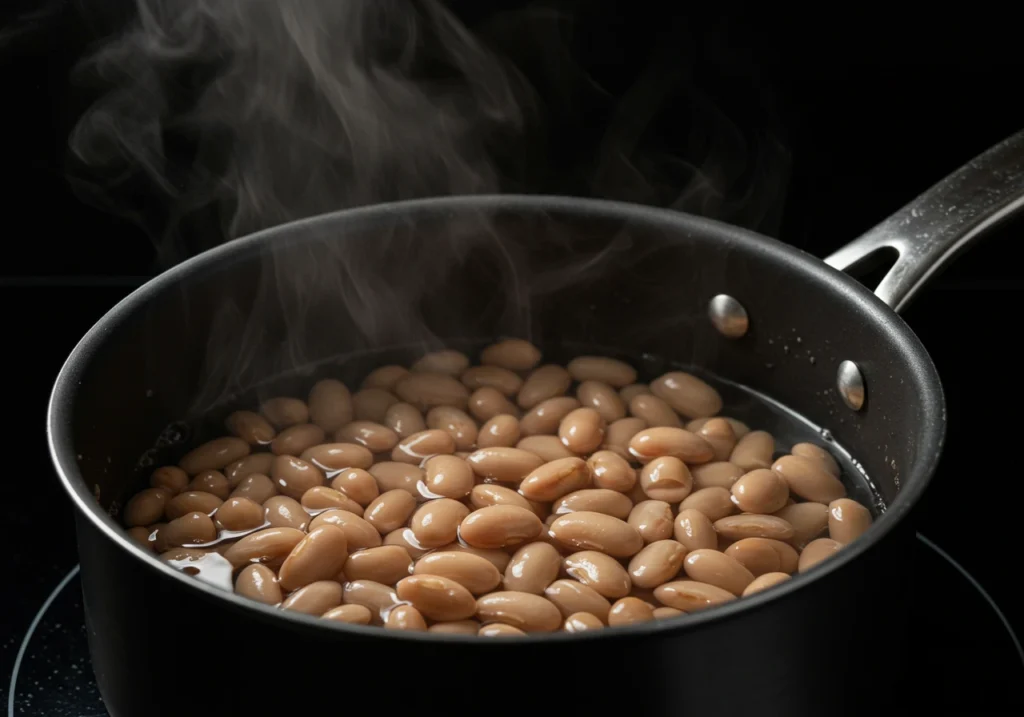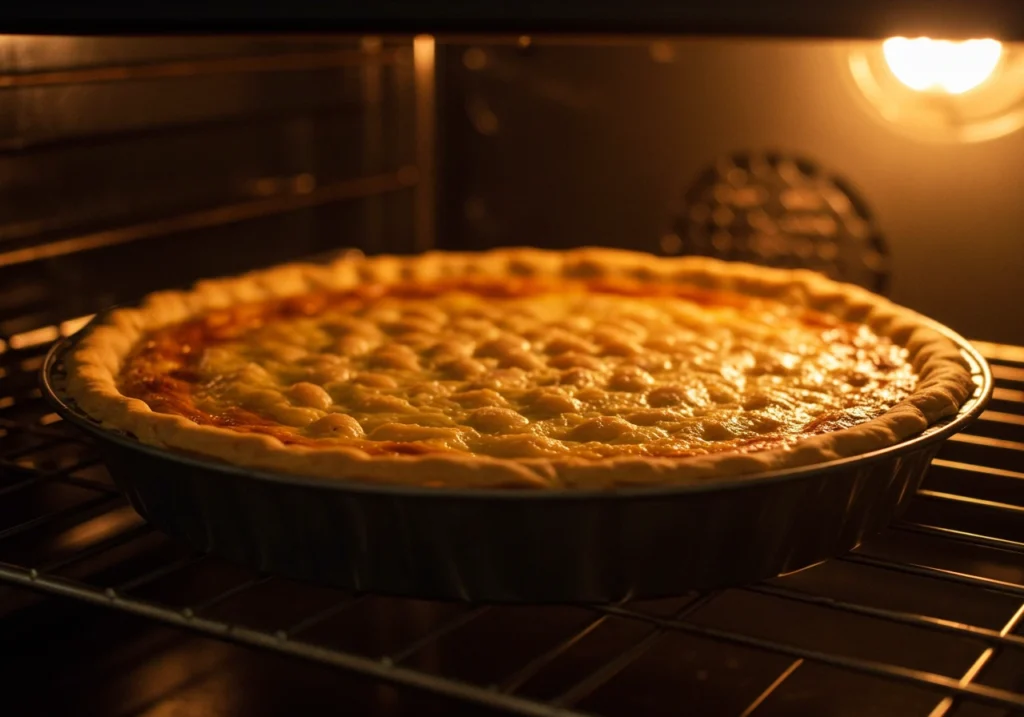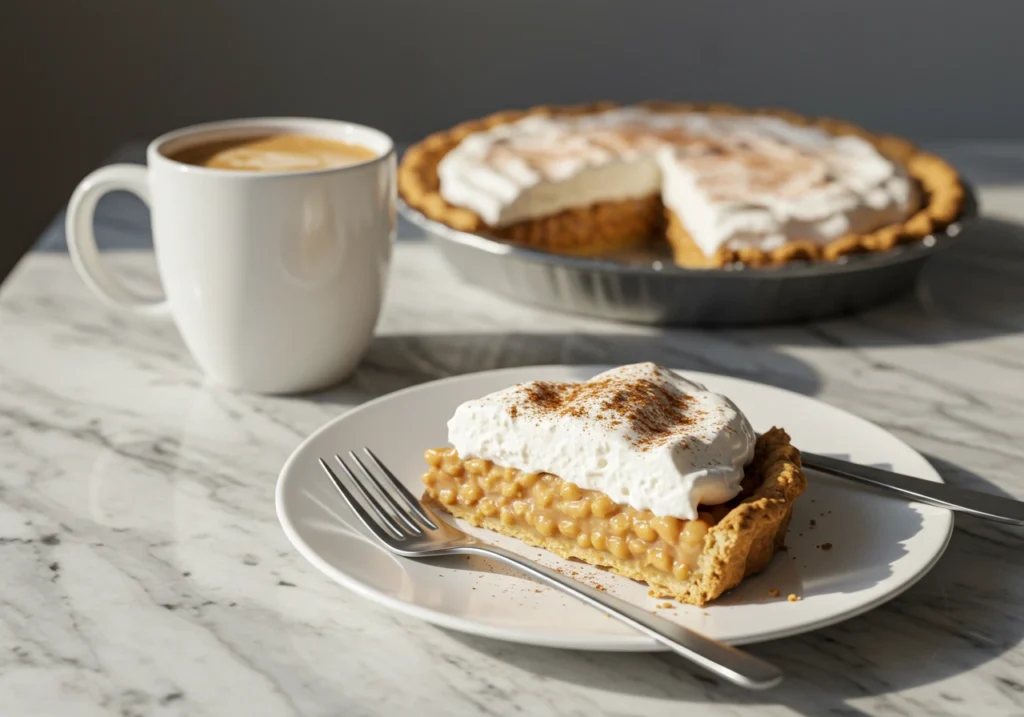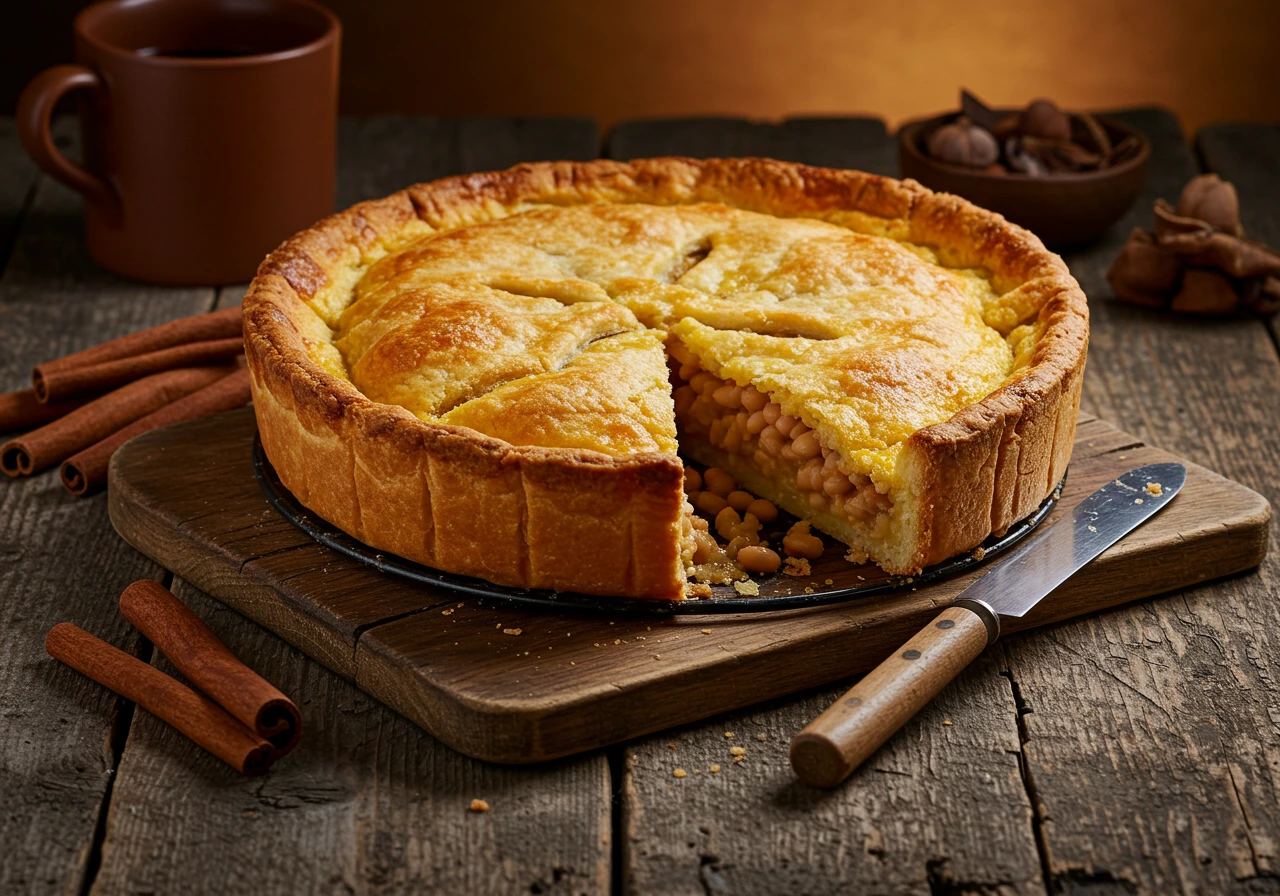Introduction to the Bean Pie Recipe
A bean pie recipe isn’t just any dessert—it’s a cultural treasure with deep historical roots, a delightful taste, and a smooth, custard-like texture. While the idea of beans in a sweet dish might raise eyebrows, trust me, once you try it, you’ll understand why this dish has stood the test of time.
Originating from African-American Muslim communities, particularly the Nation of Islam, bean pie recipe was developed as a nutritious and delicious alternative to traditional desserts. It’s a perfect blend of navy beans, warm spices like cinnamon and nutmeg, and a flaky crust, making it both wholesome and indulgent.
In this detailed guide, we’ll dive into every aspect of the bean pie recipe, from its historical origins to step-by-step preparation methods. You’ll learn not only how to make this dessert from scratch but also how to tweak it to fit different dietary preferences. Whether you prefer a classic approach or a modern twist, you’ll find a variation that suits your taste.
So, let’s roll up our sleeves and start this flavorful journey!
Part 1: Introduction and Historical Background
A Sweet Tradition: The Story of bean pie recipe
Before we get our hands dirty in the kitchen, it’s essential to understand where this sweet bean custard pie comes from and why it remains a cherished dish in many households today.
Roots in African-American Muslim Communities
The bean pie recipe is more than just a dessert—it’s a piece of history. It was introduced by the Nation of Islam (NOI) in the early 20th century as part of a dietary shift away from traditional Southern foods that contained excessive fats and sugars. Elijah Muhammad, the founder of NOI, encouraged healthier eating habits, promoting the consumption of navy beans as a source of protein and fiber.
Navy beans were chosen for their nutritional benefits, as they are high in protein, fiber, and essential nutrients. Instead of using them in savory dishes, the community found a way to transform these humble beans into a rich, flavorful pie that became a staple in many Muslim households.
Today, while the dessert remains deeply rooted in the NOI tradition, it has gained mainstream popularity. Even those outside the community enjoy it for its unique taste and texture.
Read more about the cultural significance of bean pie here.
Evolution of bean pie recipe Over Time
Like any traditional dish, the bean pie has evolved. Early versions were simple, using just a handful of ingredients, but modern adaptations incorporate everything from coconut milk for a vegan touch to gluten-free crusts for those with dietary restrictions.
Even within the African-American community, bean pie has transitioned from being a dish mainly prepared by NOI members to one that appears in home kitchens, bakeries, and even some restaurants. This evolution showcases its versatility while still preserving its original essence.
Today, you’ll find variations that swap white sugar for honey or maple syrup, introduce new spices like cardamom, or even add a splash of vanilla extract for extra depth. Some bakers prefer a silkier custard-like filling, while others go for a firmer, heartier bite.
Why You Should Try a bean pie recipe
Still skeptical about putting beans in dessert? Here’s why you should give it a shot:
Rich in Nutrients – Unlike many desserts that are heavy in processed sugars and fats, bean pie offers a good balance of protein and fiber, making it a more filling option.
Unique Flavor Profile – It’s like a mix between sweet potato pie and custard pie, but with a smoother texture.
Great for Any Occasion – Whether for a holiday feast, Sunday dinner, or a simple weekday treat, bean pie never disappoints.
Easy to Customize – It’s adaptable to various dietary needs without compromising its signature taste.
Part 2: Understanding the Ingredients
Core Ingredients of bean pie recipe
A great bean pie relies on the perfect blend of ingredients, each playing a crucial role in achieving that smooth, custard-like texture and warm, spiced flavor. While the recipe may seem simple at first glance, every ingredient contributes to the depth of taste, consistency, and richness that makes this dessert stand out.
Navy Beans: The Star of the Show
It might sound unusual, but navy beans are the heart of this dish. Unlike typical pie fillings, which rely on pumpkin, sweet potatoes, or custards, bean pie uses these small, creamy legumes to create a smooth and velvety consistency.
Why Navy Beans?
Navy beans are mild in flavor and blend easily into a creamy base, making them the ideal secret ingredient for a custard-like pie filling.
Preparation Matters
- If using dried beans, soak them overnight and then simmer them until they are soft enough to mash effortlessly.
- If using canned navy beans, drain and rinse them well to remove excess sodium before blending.
The key is to achieve a silky texture, which means the beans must be thoroughly cooked and blended until completely smooth.
Sweeteners: Finding the Right Balance
Every good pie needs a touch of sweetness, and bean pie is no exception. Traditionally, granulated sugar is used, but many bakers opt for alternative sweeteners to enhance the pie’s flavor profile.
White Sugar: Provides a clean, neutral sweetness, allowing the warm spices to shine.
Brown Sugar: Adds a touch of molasses, deepening the pie’s richness and caramel notes.
Alternative Sweeteners: If you’re looking for a healthier option, consider using honey, maple syrup, or coconut sugar. These bring a natural sweetness while slightly altering the texture.
Whatever sweetener you choose, balance is key—you want just enough to complement the natural mildness of the navy beans without overpowering the spices.
Dairy Components: The Key to Creaminess
A true bean pie has a luscious, creamy consistency, which comes from the use of evaporated milk and butter.
Evaporated Milk: This thickened milk adds richness without making the filling too heavy. It also enhances the custard-like texture, ensuring a smooth finish.
Butter: A small amount of melted butter introduces a subtle depth of flavor, making the filling velvety and luxurious.
For dairy-free versions, coconut milk or almond milk can be excellent substitutes for evaporated milk, while vegan butter or coconut oil can replace butter without sacrificing creaminess.
Spices and Flavorings: The Secret to Depth
What makes bean pie truly shine is the warm, aromatic blend of spices and flavorings that give it its signature taste.
Cinnamon & Nutmeg: These classic spices provide a cozy, comforting warmth.
Vanilla Extract: A splash of vanilla enhances the overall sweetness and rounds out the flavors.
Ginger & Cloves: Some variations add a pinch of these for extra depth.
Salt: Just a pinch helps balance the sweetness and brings out the richness of the beans and spices.
Each of these ingredients plays a part in creating that perfect harmony of flavors, making bean pie a truly unique dessert.
Nutritional Profile of bean pie recipe
While it’s a dessert, bean pie surprisingly offers a range of nutritional benefits thanks to its star ingredient—navy beans.
Macronutrients: A Balanced Dessert Option
Protein-Rich: Unlike many traditional pies, bean pie provides a decent amount of protein, thanks to navy beans. This makes it a more filling and satisfying dessert option.
Fiber-Packed: Navy beans are an excellent source of fiber, which helps with digestion and promotes a feeling of fullness.
With a balance of carbohydrates, healthy fats, and protein, this dessert is both indulgent and relatively nutritious.
Micronutrients: More Than Just a Treat
Iron & Magnesium: Navy beans are packed with iron and magnesium, which support energy levels and muscle function.
B Vitamins: Essential for metabolism and overall well-being.
Antioxidants: Spices like cinnamon and nutmeg offer anti-inflammatory and antioxidant properties, making this pie a guilt-free pleasure in moderation.
This isn’t just any dessert—it’s a nutrient-rich treat that allows you to indulge without completely straying from a balanced diet.
Part 3: Step-by-Step Preparation Guide
Now that we’ve covered the history and ingredients of bean pie, it’s time to get into the fun part—the preparation! Whether you’re making it from scratch with dried navy beans or opting for the convenience of canned beans, this step-by-step guide will walk you through the entire process. Plus, we’ll cover both homemade and store-bought pie crusts, ensuring you get the best results regardless of your skill level in the kitchen.
Preparing the Beans
The key to a silky-smooth bean pie filling lies in properly preparing the beans. Since navy beans are the main ingredient, they must be soft enough to blend seamlessly into a custard-like consistency.
Soaking and Cooking Dried Beans
If you’re using dried navy beans, here’s how to prepare them for the best texture:
Step 1: Rinse and Soak – Rinse 1 cup of dried navy beans under cool water, removing any debris. Soak them in a large bowl of water overnight (at least 8-12 hours). This reduces cooking time and ensures a soft texture.
Step 2: Cook Until Tender – Drain the soaking water and transfer the beans to a large pot. Cover with fresh water and bring to a boil. Reduce heat and simmer for about 60-90 minutes, or until the beans are soft enough to mash with a fork.
✔ Step 3: Drain and Cool – Drain the beans and let them cool before blending.
💡 Pro Tip: Add a pinch of baking soda to the boiling water to help soften the beans even further.

Using Canned Beans
For a quicker alternative, canned navy beans save time without compromising flavor:
Step 1: Drain and Rinse – Empty one 15-ounce can of navy beans into a strainer and rinse under cold water to remove excess sodium.
Step 2: Warm Slightly – For a smoother blend, heat the beans for a few minutes in a pot over low heat before blending.
While canned beans may be a shortcut, they still deliver a creamy, custard-like filling when blended properly.
Making the Pie Crust
A bean pie is only as good as its crust! You can go the traditional route and make a homemade crust, or opt for the ease of a store-bought crust.
Traditional Homemade Crust
Making a buttery, flaky pie crust from scratch is easier than you think! Here’s what you’ll need:
Ingredients:
- 1 ¼ cups all-purpose flour
- ½ teaspoon salt
- ½ cup unsalted butter, cold and cubed
- 2-4 tablespoons ice water
Step-by-Step Instructions:
Combine Dry Ingredients – In a large bowl, mix the flour and salt.
Cut in the Butter – Use a pastry cutter or fork to blend in the cold butter until the mixture resembles coarse crumbs.
Add Ice Water – Gradually add one tablespoon at a time, mixing until the dough comes together.
Chill the Dough – Shape into a disk, wrap in plastic, and refrigerate for at least 30 minutes.
Roll and Fit into Pie Dish – Roll out the dough on a floured surface to fit a 9-inch pie pan. Press it in and crimp the edges.
💡 Pro Tip: Pre-baking the crust for 5 minutes at 375°F can help keep it from getting soggy when adding the filling.
Store-Bought Crust Options
If making a crust from scratch isn’t your thing, pre-made pie crusts work just fine. Here’s what to consider:
✔ Frozen Pie Crusts: Available in ready-to-bake shells—just let them thaw before filling.
✔ Refrigerated Dough: Roll out into a pie pan for a more homemade feel.
Either way, make sure to prick the bottom with a fork before filling to prevent bubbling.
Creating the Filling
Now for the magic! The filling is what sets bean pie apart from other custard-based desserts. Proper blending ensures a creamy, lump-free texture.
Blending Ingredients
Here’s what you’ll need for the classic filling:
Ingredients:
- 1 ½ cups cooked navy beans (or one 15-ounce can, drained and rinsed)
- 1 cup evaporated milk
- ¾ cup granulated sugar (or brown sugar for extra richness)
- ½ stick melted butter
- 2 large eggs
- 1 teaspoon vanilla extract
- 1 teaspoon cinnamon
- ½ teaspoon nutmeg
- ¼ teaspoon salt
Steps for the Perfect Texture:
Blend Beans First – Using a blender or food processor, puree the navy beans until smooth.
Add Liquids – Pour in the evaporated milk, melted butter, and vanilla extract, blending until combined.
Sweeten and Spice – Add sugar, cinnamon, nutmeg, and salt to the mix.
Incorporate Eggs – Crack in the eggs and blend on low speed until fully incorporated.
Adjusting Sweetness and Spice Levels
Depending on your preference, tweak the flavor:
richer taste: Use brown sugar instead of white sugar.
extra spice: Add a pinch of ginger or cloves.
less sweet pie: Reduce the sugar by ¼ cup.

Assembling and Baking the Pie
With your crust ready and filling blended, it’s time to bring everything together!
Combining Crust and Filling
Preheat Oven – Set your oven to 350°F (175°C).
Pour the Filling – Gently pour the bean pie filling into the prepared crust, smoothing out the top.
Tap for Air Bubbles – Lightly tap the pie dish on the counter to remove any air pockets.
Baking Tips for the Perfect Pie
Bake to Perfection – Place the pie in the oven and bake for 45-50 minutes, or until the center is set but slightly jiggly.
Check for Doneness – Insert a toothpick in the center; it should come out mostly clean. Step 6: Cool Completely – Let the pie cool at room temperature for at least 1 hour before slicing.
💡 Pro Tip: For a smoother texture, cover the edges of the crust with foil during the last 15 minutes of baking to prevent over-browning.
Part 4: Variations and Serving Suggestions
So, you’ve mastered the classic bean pie recipe—but what if you want to switch things up? Whether you’re catering to dietary preferences or just looking to experiment with flavors, bean pie is versatile enough to adapt to different lifestyles.
From vegan-friendly versions to gluten-free alternatives, let’s explore how to tweak this pie while keeping its signature creamy texture and warm, spiced flavor intact.
Recipe Variations
Traditional bean pie is already unique, but there are plenty of ways to make it plant-based, allergy-friendly, or just a little different. Here are two of the most popular variations.
Vegan Bean Pie
Cutting out dairy and eggs doesn’t mean sacrificing flavor! A vegan bean pie can be just as creamy and indulgent with the right substitutions.
Dairy-Free Replacements:
- Instead of evaporated milk, use coconut milk or almond milk for a creamy base.
- Swap butter with vegan butter or coconut oil to maintain that silky richness.
Egg Substitutes:
- Use flax eggs (1 tablespoon ground flaxseed + 3 tablespoons water per egg).
- Try unsweetened applesauce or mashed banana (¼ cup per egg) for a natural binder.
Sweetener Adjustments:
- Instead of white sugar, opt for maple syrup, agave, or coconut sugar to keep it fully plant-based.
💡 Pro Tip: Since plant-based versions may take longer to set, bake at 325°F (163°C) for 50-55 minutes and allow extra cooling time.

Gluten-Free Options
Want a gluten-free bean pie? The filling itself is naturally gluten-free, so all you need is the right crust.
Nut-Based Crust: Blend almond flour, coconut flour, and a bit of maple syrup for a slightly sweet, nutty crust.
Oat Crust: Use gluten-free oat flour with coconut oil and a pinch of salt for a light but sturdy crust.
Store-Bought Options: Many grocery stores now carry pre-made gluten-free crusts, which work well for convenience.
💡 Pro Tip: If your gluten-free dough is too crumbly, add a teaspoon of chia seeds mixed with water for better binding.
Serving Suggestions
A perfectly baked bean pie is a treat on its own, but the right accompaniments and presentation can elevate it even further.
Accompaniments
Want to add a little extra flair to your slice? Here are some perfect pairings to enhance the pie’s flavor:
Whipped Cream: A dollop of homemade whipped cream or coconut whipped cream balances the spices beautifully.
Ice Cream: Pair with a scoop of vanilla, cinnamon, or butter pecan ice cream for a heavenly contrast of textures.
Fresh Fruits: A side of sliced bananas, berries, or caramelized apples brings in natural sweetness and freshness.
Drinks: Serve alongside a warm cup of spiced chai, black tea, or coffee for the ultimate cozy experience.
💡 Pro Tip: Sprinkle a touch of cinnamon or nutmeg over the whipped cream for extra warmth and depth.
Presentation Tips
They say we eat with our eyes first, so why not make your bean pie look as good as it tastes?
✔ Slicing Like a Pro: Use a sharp, warm knife to get clean slices—dip it in hot water and wipe between cuts.
✔ Garnishing Ideas:
- Dust the top with cinnamon or powdered sugar for an elegant touch.
- Drizzle a little honey or caramel over the slice for a glossy finish.
- Garnish with a mint leaf or orange zest for a pop of color.
💡 Pro Tip: If serving at a dinner party, plate each slice with a drizzle of chocolate sauce and a few fresh berries for a restaurant-quality presentation.
Part 5: Cultural Significance and Modern Adaptations
While bean pie is undoubtedly a delicious and unique dessert, its significance runs far deeper than its taste. It holds an essential place in African-American Muslim culture, serving as a symbol of community, self-sufficiency, and tradition. Beyond its cultural roots, bean pie has also found its way into popular media and has even been adapted into modern variations, making it a dessert that continues to evolve.
Cultural Importance
The bean pie isn’t just food—it’s a symbol of resilience, heritage, and community. Its history is deeply tied to the Nation of Islam (NOI) and the broader African-American experience in the U.S.
Symbolism in African-American Muslim Communities
The origins of bean pie trace back to the early 20th century, when Elijah Muhammad, leader of the Nation of Islam (NOI), emphasized a diet rooted in health, discipline, and self-reliance. He encouraged the consumption of navy beans, believing they were a nutritious and sacred food. Instead of traditional Southern desserts made with sweet potatoes or pecans, bean pie emerged as a staple in NOI households.
A Sign of Self-Sufficiency: NOI members often sold bean pies as a way to support their communities and spread their teachings. They were commonly seen at street corners, mosques, and community events.
A Gathering Dish: Much like sweet potato pie in the broader Black American culture, bean pie became a fixture at family gatherings, religious events, and special occasions.
A Healthier Alternative: With its fiber-rich beans and natural sweetness, it was seen as a better choice than heavier, sugar-laden desserts.
Even today, bean pie remains a comfort food for many African-American Muslim families, holding a sacred place in cultural traditions.
Representation in Media
Over the years, bean pie has made its way into music, television, and literature, reflecting its cultural relevance beyond the NOI.
Hip-Hop and Music Mentions:
- Rapper Lupe Fiasco references bean pies in his song Muhammad Walks, highlighting its ties to Black Muslim culture.
- In jazz and soul music, bean pie is sometimes mentioned as a nostalgic dish linked to the civil rights era.
Appearances in Film & TV:
- In Spike Lee’s movies, there are nods to the presence of bean pies in Black communities.
- Various documentaries on African-American cuisine showcase bean pie as a historical dish.
In Literature:
- Novels and memoirs detailing African-American Muslim experiences often mention bean pie as a symbol of heritage and identity.
Beyond just a food item, bean pie represents a story of culture, history, and perseverance—one that continues to be told.
Modern Takes on bean pie recipe
While bean pie remains deeply rooted in its traditional recipe, modern bakers have found creative ways to adapt it to contemporary tastes and dietary needs.
Fusion Recipes
By blending traditional flavors with new ingredients, bean pie is finding its place in the modern culinary world.
Pumpkin Spice Bean Pie: A mix of pumpkin purée and navy beans gives the pie a hybrid taste reminiscent of fall flavors.
Chocolate Bean Pie: Adding cocoa powder or melted chocolate transforms this into a rich, fudgy dessert.
Coconut Bean Pie: Swapping evaporated milk for coconut milk and adding shredded coconut gives it a tropical twist.
Spiced Chai Bean Pie: Infusing chai spices like cardamom, ginger, and cloves creates a bold, aromatic version.

💡 Pro Tip: Experiment with different extracts (almond, orange, or rum) to enhance the flavor profile.
Health-Conscious Adaptations
With more people looking for healthier dessert options, bean pie has been adjusted to cater to low-sugar, gluten-free, and dairy-free diets.
Low-Sugar Version:
- Replace white sugar with honey, agave syrup, or monk fruit sweetener to cut down on refined sugars.
High-Protein Pie:
- Adding extra navy beans and a scoop of vanilla protein powder boosts protein content without compromising taste.
Keto-Friendly Bean Pie:
- Swap out traditional pie crust for an almond flour crust and use erythritol or stevia instead of sugar.
Part 6: Frequently Asked Questions (FAQs)
As bean pie continues to gain popularity beyond its traditional roots, many people have questions about its ingredients, taste, and significance. Below, we answer some of the most frequently asked questions about this unique and historically rich dessert.
What Kind of Beans Are Bean Pies Made Of?
Navy beans are the traditional choice for making bean pie. These small, white legumes have a mild, slightly nutty flavor and blend into a creamy texture when cooked.
Why navy beans?
- They are soft and easy to mash, making them ideal for a smooth pie filling.
- They have a neutral taste, allowing the spices and sweetness to shine.
- They are nutrient-dense, providing protein, fiber, and essential vitamins.
💡 Can you use other beans?
While navy beans are the standard, some bakers experiment with white beans, cannellini beans, or even chickpeas. However, these alternatives may slightly alter the flavor and texture of the pie.
Are Bean Pies Healthy?
Yes, compared to many traditional pies, bean pie offers some nutritional benefits thanks to its high-fiber, high-protein base.
Health Benefits of Bean Pie:
Protein-Rich: Navy beans provide a plant-based source of protein, making the pie more satisfying.
Fiber-Packed: Helps with digestion and blood sugar control.
Lower in Fat: Unlike custard-based or cream-heavy pies, bean pie relies on minimal butter and dairy.
Spice-Infused Benefits: Spices like cinnamon and nutmeg have anti-inflammatory and antioxidant properties.
💡 Healthier Modifications:
- Use natural sweeteners like honey or maple syrup instead of white sugar.
- Swap evaporated milk for coconut milk for a dairy-free option.
- Reduce the crust thickness or opt for gluten-free almond flour crusts for fewer carbs.
While bean pie is still a dessert, its nutrient profile makes it a better-for-you choice compared to heavy cream pies or sugar-loaded pastries.
Does Bean Pie Taste Like Sweet Potato Pie?
In many ways, bean pie has a similar texture and spice profile to sweet potato pie, but there are subtle differences.
Similarities:
- Both pies are custard-like with a smooth, creamy filling.
- They use warm spices like cinnamon, nutmeg, and vanilla.
- They have a sweet, rich taste and are often served during holidays or special gatherings.
Differences:
- Bean pie is milder and less earthy than sweet potato pie.
- Sweet potato pie has a more pronounced natural sweetness, while bean pie relies more on added sugar.
- Bean pie has a slightly nuttier, creamier consistency due to the blended navy beans.
💡 If you love sweet potato pie, chances are you’ll enjoy bean pie too! It’s like a smoother, slightly less sweet version with the same comforting flavors.
What Is the Significance of the bean pie recipe?
Bean pie holds deep cultural and historical significance, especially within African-American Muslim communities.
Origin in the Nation of Islam (NOI):
- Introduced as a health-conscious alternative to traditional Southern desserts.
- Elijah Muhammad encouraged navy beans in the diet due to their nutritional value.
- Often sold as a fundraising tool in NOI communities, helping members support their organizations.
Symbol of Self-Sufficiency and Community:
- Bean pie was more than just food—it represented economic independence and self-reliance.
- Members of the NOI often sold freshly baked bean pies on street corners, in bakeries, and at religious gatherings.
Mainstream Recognition:
- Over the decades, bean pie became known beyond the Nation of Islam, gaining a spot in the larger African-American culinary tradition.
- Today, it is still a beloved dessert, found at family gatherings, bakeries, and cultural festivals.
Part 7: Reflecting on the bean pie recipe Experience
A Dessert Worth Discovering
After diving deep into the history, preparation, and cultural significance of bean pie, it’s clear that this dessert is more than just a sweet treat—it’s a culinary experience. The combination of creamy navy beans, warm spices, and a buttery crust creates a pie that is both unique and comforting. Whether you grew up eating bean pie or just discovered it, there’s something special about its mild sweetness and smooth texture that makes it stand out.
Trying the recipe firsthand was a pleasant surprise. At first, the idea of using beans in a dessert seemed unusual, but after tasting that first slice, it all made sense. The balance of cinnamon, nutmeg, and vanilla creates a warm, nostalgic flavor, while the navy beans provide an unexpectedly smooth and rich consistency. It’s like a fusion of custard pie and sweet potato pie, but with its own distinct character.
Share the Legacy of bean pie recipe
One of the best things about bean pie is that it brings people together. Whether you make the classic version, try a vegan or gluten-free adaptation, or experiment with new flavors, this pie is meant to be shared.
Introduce it to friends and family—it’s always fun to watch their reaction when they find out the secret ingredient!
Keep the tradition alive by making it for gatherings, holidays, or just a cozy night in.
Experiment with flavors and make it your own—this is a recipe that welcomes creativity.
If you haven’t tried making a bean pie yet, now’s the time! You might just discover your new favorite dessert—and a story worth telling along the way. 🍽️

